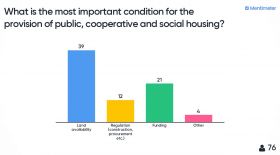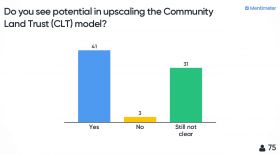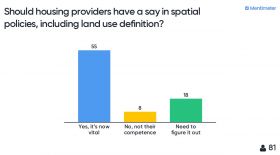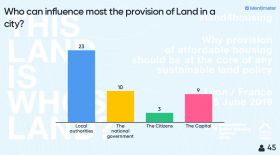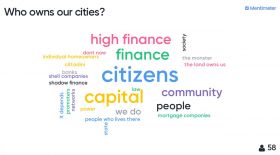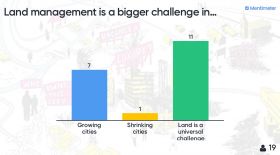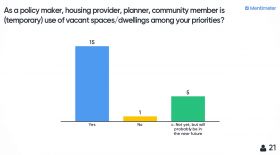The big battle of our times against financialization of Land and Housing
All you need to know from our annual conference 'This Land is whose Land?'
Lyon, 14 June 2019 | Published in Urban, Economy, Social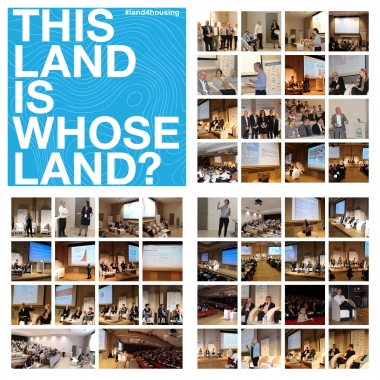
Every intervention added another piece on the puzzle but the overall image was quite obvious from the beginning. A big battle, probably the defining battle of our times concerning the kind of society we want to live in the future, is taking place at the moment. And cities are the battlefield. The ongoing financialization of urban land and housing is expelling people. This does not make any sense. Policy makers, housing providers, the academia and above everyone else the citizens have realised that the change of course has to happen now. On June 6th thanks to a truly diverse and thought-provoking lineup of speakers we were able to understand better what is really at stake in this battle, to draw inspiration from small and big wins across Europe while having an open exchange on what can be done from now on.
More than 310 people took seat at the Catholic University of Lyon for the annual conference of Housing Europe themed 'This Land is whose Land?' on June 6th - day 3 of the International Social Housing Festival. Below we summarize the highlights of the day, including links to any slides used throughout the day, the results of the polling sessions with our audience and a big selection of images. We also encourage to follow again the action on Twitter and to read our moderator's point of view in his blog post.
Welcome session
The President of Housing Europe, Cédric van Styvendael kicked off the event stressing the importance of the Land question for public, cooperative and social housing providers. Cédric also outlined the nature of the housing crisis and the impact on households saying that "when real estate prices rise, the society gets poorer". Since everyone in Europe and around the world today unanimously agrees that affordable and sustainable housing is facing a state of emergency, Cédric called for an alliance of the forces of progress with the Festival as the starting point.
The Vice-President of Grand Lyon Metropole, in charge of Housing and Urban Planning, Michel Le Faou shared how the Festival host city deals with the housing question that still touches upon the lives of many people. Mr Le Faou explained that although Lyon is not at the same level as other international cities like Paris and New York the impact of the growing prices and lack of growth in income is alarming. How is Lyon handling this? Targetting social mix in their urban plan by giving the local authories certain tools, for instance, 30% of new developments should be regulated housing. They also impose certain restrictions such as giving a lower land price in exchange for lower prices for sale.
Session I - The long-term effects of land use. Why we need to shape today the cities of 2050
Due to a last minute change to the schedule, the conference started with the first panel session that explored the effects of land policy choices offering multiple points of view.
Josep Maria Montaner, City of Barcelona Housing Councillor stressed that affordability is an issue in the Catalan capital, as now it is more expensive to rent in Barcelona than in 2008. Families are being excluded from the housing market because of the de-link between supply and demand. The Colau administration's action plan evolves around three main pillars: preventing privatisation of public land, promoting social rental & collaborative housing initiatives and sharing responsibility with the private sector.
Solveig Råberg Tingey, Chief Economist of Housing Europe Danish member, BL explained how Danish social housing providers are on a mission against segregation. BL created a Master Plan in two elements: Material and Social – which features policies and actions relating to urban infrastructure, renovations, internships and educational guidance, housing social clubs, homework cafes and leisure jobs. The success story of Aalborg East is only one concrete example that proves that the strategy works bringing multiple added value to the local community.
Caroline Lucats, Director of Housing and Urban & Health Risks at the City of Lille and Benoît Tracol, CEO of Rhone Saone Habitat and Director of ORSOL, explored the question, “Community Land Trusts. Do people have the land power?” providing their perspectives. Caroline said that the Community Land Trust model helps the City of Lille serve its objective to be an open, affordable city for all. What began as an innovation at the local level in Lille, very quickly became national law and numerous projects are being proposed, planned or are under-way. At the same time, The City of Lille joined the INTERREG North-West Europe project Sustainable Housing for Inclusive and Cohesive Cities (SHICC), along with CLT Brussels, CLT Ghent, Ville CLT, Bristol CLT, London CLT and the National CLT Network UK, all hoping to spread the good CLT word. Benoit Tracol of ORSOL gave the housing providers' perspective on the potential of CLT for cities like Lyon. Benoit presented quite a few concrete examples in the wider region around Lyon, making the case that the OFS model is a secure weapon against speculation in land and housing.
During the first flash intervention beyond Europe, György Sümeghy, Advocacy Manager, Europe, Middle East and Africa at Habitat for Humanity International, outlined briefly the key points Habitat’s campaign, “Secure Tenure & Land - Solid Ground’s Principles for secure tenure”. One of the biggest obstacles of housing development in the Global South is access to land but also lack of data, parallel legal systems where you have the constitution but also customary systems in developing countries. There is also a Gender issue as women cannot inherit land. In many countries, people are not aware of the law or their right to education. Long story short 'This Land is whose Land?' is a literary questions in big parts of the world.
Sarah Boyack, Vice Chair, Scottish Government’s Vacant & Derelict Land Task Force & Head of Public Affairs, Scottish Federation of Housing Associations (SFHA) gave an insightful presentation on the land question in Scotland- what do SFHA members do, how does the government Land Commission help them address the rather significant land challenge? 1/3 of the population lives 500 meters from a derelict site while another 1/4 live between 500 and 1000 meters from a derelict site, stressing that "the ultimate aim is by 2028 all vacant and derelict land to be available to the people of Scotland". "Vacant and derelict land is an opportunity for housing providers to transform it into communities where people would love to live in" was Sarah's positive conclusion for the first panel of the day.
You may find at the bottom of the page the audience's point of view to the questiosn addressed in the beginning and during the course of the session.
Keynote Session - Who owns our cities?
A devoted student of cities, immigration, and states in the world economy, with inequality, gendering and digitisation three key variables running though her work, Robert S. Lynd Professor of Sociology at Columbia University & Member of its Committee on Global Thought, Saskia Sassen addressed in her keynote speech the central question she has coined in the public discourse “who owns our cities?”. Saskia took conference participants to a journey through the dynamics behind this urban land takeover that is in full swing, clarifying from the beginning that "I have never really been a housing person but my work on high finance inevitably got me interested in the housing question".
"High Finance is the steam engine of our time" made Saskia Sassen the case sheding light on the 'dark pools' of Finance that really affect housing provision. Looking at the empty urban land and at the same time at the data of huge investments in urban property one cannot help but wondering 'what the hell is going on?', stressed Saskia who illustrated the incredible contradictions of the top 100 cities in the world by property investment that gather just 10% of the world population, 30% of the GDP and 76% of property investment! Regarding empty urban buildings Sassen highlighted "we may see the empty buildings but what actually is there, it is a field of assets".
Concluding her speech, Saskia got everyone thinking about the urban formats of the future, as indeed this is the big picture everyone should have in their mind, especially now that global networks of property investment are taking over from the communities the right to shape the present and future of our cities. Actually one of the main points raised by the International Social Housing Festival, too.
The keynote was followed by a discussion with David Orr CBE, International Housing Expert, Chair of Reall & Board Member of Clarion Housing Group, Donal McManus, CEO of the Irish Council for Social Housing (ICSH) and Sjoerdje Van Heerden, Scientific Officer at the Joint Research Center of the European Commission, CiTown Project.
David Orr suggested that "we should convince global investors Saskia talked about that investing in affordable housing is an asset for them" that brings great social returns, too. There are ways: "you cannot force people to house people but you can tax empty property", he said.
Donal McManus turned the debate to the question "Can financialization be managed?" Finding an answer to this question definitely should start by addressing a more fundamental point - transparency on who owns the land, he said calling for political action at local, national and international level, as for example at UN level.
Sjoerdje Van Heerden stressed also from her side that we have to deal with this high finance that may not run the cities, but explains a lot of what goes on in cities. Sjoerdje said that she is left with a sense of urgency highlighting that it should be clear who does one address from now on when dealing with high finance as the dialogue can be multi-level.
Check out here the Word Cloud the audience built with their responses to the central question 'Who Owns our Cities?'
Session II - Growing cities, shrinking cities and cities on the fringe: the different sides of the land challenge
The afternoon session of 'This Land is whose Land' unfolded in a more workshop-like format aiming to give practical examples, pieces of advice and to share experiences around concrete issues related to the land challenge in the context of growing and shrinking cities.
Raffaele Barbato, Urban Innovative Actions (UIA) Project Coordinator, discussed “The emerging European Urban Landscapes and the Urban Innovative Actions”, highlighting how housing is present in most recent UIA calls, not just the housing-specific ones. A 5th call soon to open under UIA dedicated to demographic change, so shrinking areas and how one deals with housing there is definitely relevant, said Raffaele who shared how the UIA programme encourages exchange between cities that innovate with very practical initiatives like 'L'Autre Soie' that had hosted the UIA workshop in Lyon the day before.
Guido Schwarzendahl, Chair of Bauverein Halle & Leuna eG and Member of Cooperative Housing International Board presented- using some really great pictures- the story of the City of Halle in Germany. What happens when a city starts shrinking- populatation went down from 320k in 1975 to 230k in 2005-? "We had to develop new tools because our system is only suitable for growth", stressed Guido. In Halle we had to demolish dwellings without a future and modernize those with a future, said Guido who added that 'city-shrinking' is a massive challenge for everyone involved. It is not only an “economic accident”, but a situation predictable for decades. It is also not an isolated effect at only one spot, one region or one city… and so for exactly this reason, there is no “tool box” for it...
In the second flash intervention beyond Europe, Secretary General of Habitat International Coalition & Member of the Support Team of the Global Platform for the Right to the City, Álvaro Puertas underlined that the Right to Housing and the Right to Land are affected by financialisation and commodification worldwide calling for a balanced rural-urban development, effective participation and social function of land, while inviting to implement the Right to the City approach in Human Rights Habitat. Yet another really valuable perspective and reality check by Alvaro Puertas who reminded everyone the fundamental questions in the Global South regarding Land, Housing and the Right to the City.
Celine Di Edigio, Architect at SLRB (Housing Company of the Brussels Capital Region) showcased how our Brussels-based member is giving a new life to vacant dwellings in the urban landscape acquiring inter alia land from the private sector. Celine presented a lot of concrete examples of action taken by SLRB across Brussels to make a meaningful and diverse temporary use of vacant urban buildings.
Laura Colini, URBACT Senior Policy Expert brought the session to an end sharing insights concerning cities on the fringe based on the great work carried out with the European Territorial Cooperation programme in 9 partner cities. The common trait is that housing stock there is often in need of renovation or repurposing. This provides an opportunity to use this momentum of change to regenerate and rethink the entire area. The main lessons learnt from their work include the following points: a) the fringe is an ambiguous locution, b) the role of the municipality as a facilitator is key, c) action need to go beyond than planning, d) as the fringe is transitional crucial is to answer who is gaining from the transformation and e) radical but practical changes in the way land is used and governed are needed.
Our Secretary General, Sorcha Edwards entered the 'land of conlusion' along with our moderator, Eddy Adams at the end of the day. Here are the main points out of her notebook:
Read MoreStark contrast between responsible housing providers investing for the long-term and the extractive nature of big Finance currently impacting housing systems
Sorcha referred back to the key note speech by Saskia Sassen who presented her research findings on the hovering transient impact of big finance with no links or no interest in a city, apart from what short term profit can be extracted. While big finance is generates 73 trillion Euro by extracting wealth, in some cases turning residential buildings into mere assets, at times left empty, to back financial products and then moving swiftly on to the next sector offering potential profit-generating opportunities. Sorcha referred to the stark contrast to the picture painted by Saskia Sassen with the projects presented during the day by responsible housing providers, community land trusts and local authorities. These providers invest for the long term in inclusive projects delivering non-speculative homes.
A key question coming from the discussions, particularly in the first part of the day is to what extent or if at all, the work of big finance can be aligned with sustainable land use and local housing needs and which changes would be needed for this to happen.
In her speech, SLRB representative, Celine di Edigio reflected that, without concisely making it part of their strategy, SLRB members, by developing long – term affordable and social housing, often on former industrial sites which have become derelict, and turning these into sustainable neighbourhoods are serving as a protective shield or counteractive measure to the negative impact of speculative short-term investment and financialization.
Turning eyesores and derelict sites into attractive housing developments
Sorcha also referred to the point raised by SFHA’s Sarah Boyack on how the attractiveness of the development is crucial. Sarah in her presentation presented statistics which showed that low income and marginalised groups are more likely to live near derelict sites. Sorcha stressed that the importance of the attractiveness of housing developments is a factor which can counteract NIMBYISM, often an obstacle to the developments of social housing. Housing developments which are aesthetically pleasing and which offer facilities such as green spaces back to the broader community can help to promote public and political.
Positive side-effects of housing
Sorcha referred to the transversal nature of the impact of housing. She reminded that Raffaele Barbato representing the UIA Urban Innovative Actions initiative had told of his experience gathering project proposals for a range of calls published by the UIA, whether on circular economy, migration, poverty or health. Most proposals contained a strong housing dimension, illustrating that without housing as the basis, the other goals cannot be achieved. Sorcha stressed that on the other side, the on-going in improvement of the measurement and evaluation of the cross-sectoral impact of good housing on health, educational attainment and social inclusion. The Danish approach to this was presented by Solveig Råberg Tingey, speaking on behalf of Danish Housing Federation BL, who explained how the sector works in Denmark to build recognition of the contribution to local progress in neighbourhoods.
No borders
The International dimension which had been introduced into the discussion by Alvaro Puertas from the Habitat International Coalition and Gyorgy Sumeghy from Habitat for Humanity which indeed showed the relevance of including them in the debate showing that just as issues related to financialisation do not have borders, many of the housing and land-related rights issues are also shared. Habitat for Humanity has pointed out that a large part of their work in developing countries is linked with informing people on the laws which could offer them protection. Sorcha points out that while the issues and contexts are different, the conference today and in particular the presentation of Saskia Sassen showed the need for awareness raising among the public also has a role to play in counteracting the erosion of the public nature of land through financialisation.
Overall, a timely and thought-provoking conference with a lot of clear pointers regarding what action is needed.
